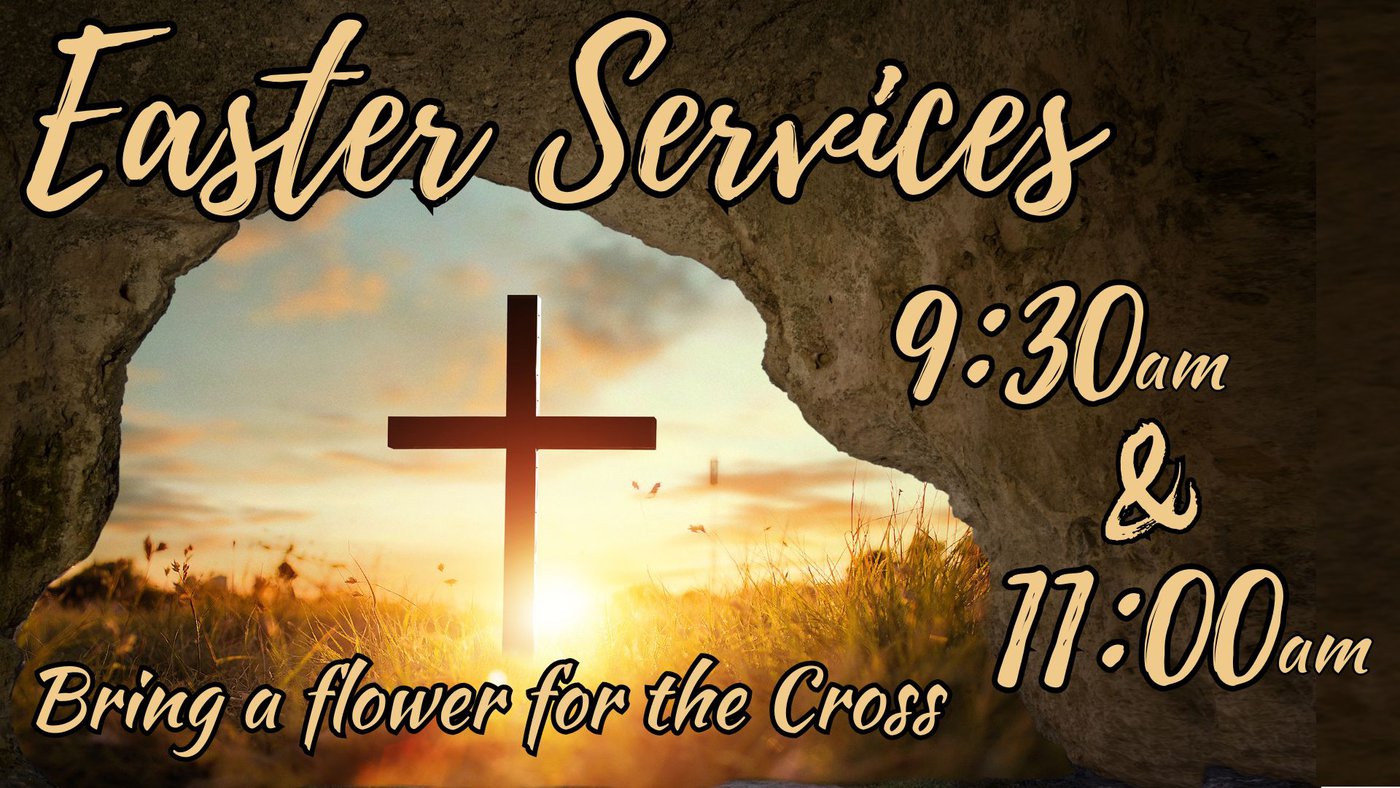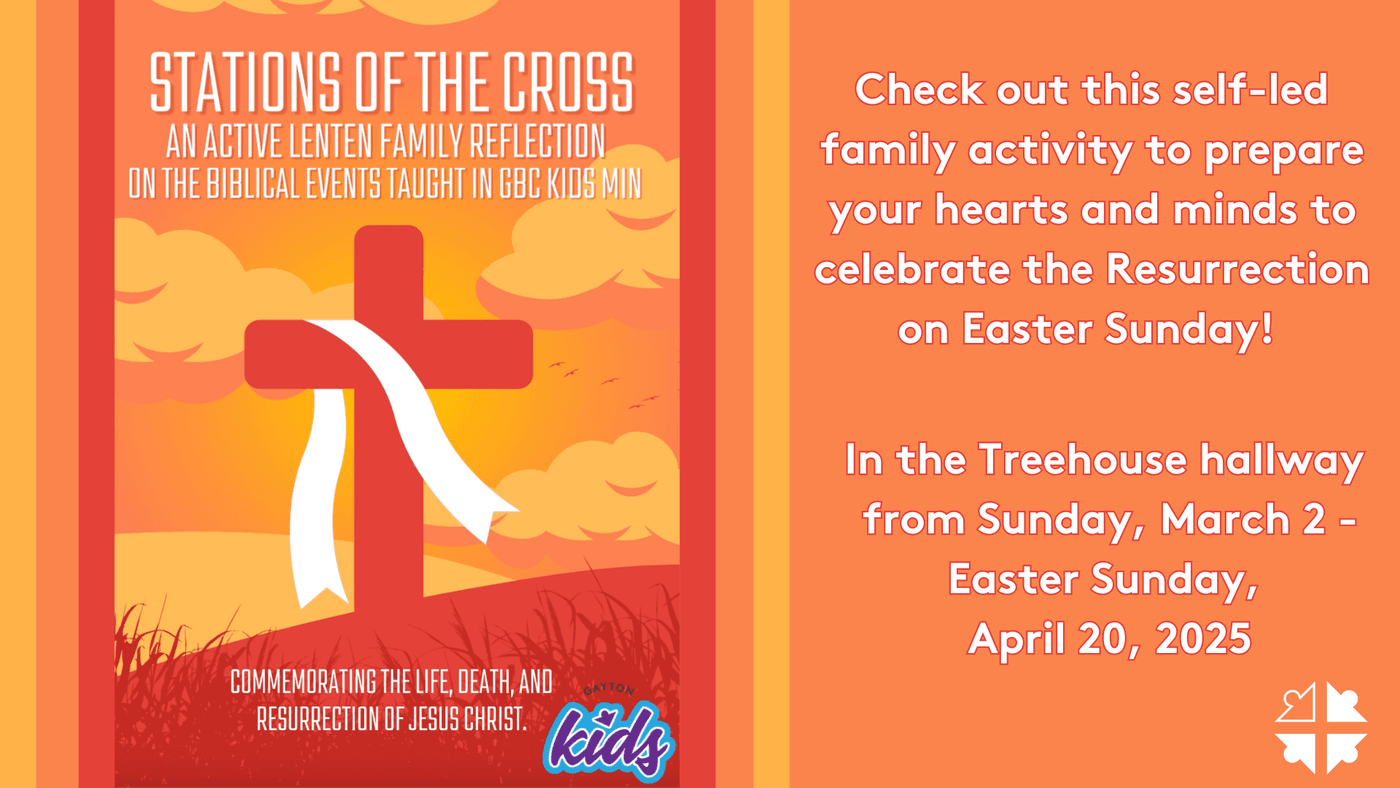
April 20, Easter Sunday- 9:30am & 11:00am
A beautiful celebration of our resurrected Lord Jesus. We will have special music from our choir and instrumentalists! We will also share in the very meaningful “Flowering of the Cross”. All are encouraged to bring flowers, living or artificial, to put on the cross, turning a symbol of death to a symbol of life! It will be a morning of worship and joy, together in Christ!

Thursday, April 17 - Maundy Thursday Service - 6:30-7:30pm
A reverent, somber, worship gathering commemorating the events leading up to Jesus’ suffering, crucifixion and death, including sharing in the Lord’s Supper and hearing the Holy Week story through scripture readings. We will share in worship and reflect on the cross and the sacrifice Jesus made for us all. All will enter and exit in quiet and reverence.
(Recommended for ages 9 and up. Parents can decide for younger children. No Kids Ministry provided.)
Lenten Reflections

Week 1
Welcome to this season of Lent!
You may have wondered about one or more of the following: What exactly is Lent? Why do people continue to observe it? Is there any specific significance associated with the 40 days?
Technically speaking, Lent is the 40-day period leading up to Easter, (excluding Sundays) that begins on Ash Wednesday and ends on Holy Saturday, the day before Easter. Historically, it has been observed as a time of prayer, fasting, and increased giving to charity.
Lent is intended to be a time of inner reflection and repentance: To be intentional about setting aside additional time to read the Bible, to pray more often, and to feel a deeper intimacy with the Lord. It is a sweet time of preparing our hearts and minds for both Good Friday and Easter. The season of Lent leads us to the cross in humility and gratitude for the great sacrifice of God on our behalf, and for the Son who bore it.
Next week we’ll dig a little deeper into those forty days. Stay tuned!
Week 2
A Multitude of Forties
The Bible is full of “forties”— occurring 158 times, to be exact. (134 in the Old Testament and 24 times in the New.) It is a significant number and can have several meanings associated with it. It can be taken literally, or it can refer to a generation of man. Often in scripture, it symbolizes a period of testing or trial.
We are likely most familiar with these references to the number 40:
*The 40 days and nights the rain flooded the earth in Genesis.
*Twice, Moses met with God on Mt Sinai, receiving the 10 Commandments for a period of 40 days and nights.
*The 40-year period when God led the Israelites through a wandering in the wilderness.
*Elijah endured 40 days without food or water at Mount Horeb.
*After the resurrection of Jesus, He continued to appear on earth for a period of 40 days.
*The Bible was written by 40 different people. (32 writers of the Old Testament, 8 writers of the New.)
Which brings us to perhaps one of the most interesting times in the life of Christ—the 40-day fast He endured while being tempted by the devil, just prior to the beginning of His public ministry.
This is the very reason we observe an intentional “fasting” of sorts during the 40-day period leading up to our Easter celebration. Next week, we will walk around a bit with Jesus through His wilderness experience.
Blessings,
Wendy Jones
Week 3
Jesus in the Wilderness
When Jesus was baptized by John, the Father spoke and the Holy Spirit descended. It was a unique earthly presence of the Holy Trinity. Following that holy encounter, Jesus was then led by the Spirit out into the wilderness, to be tested by Satan in advance of His public declaration of being our long-ago prophesied Messiah.
What strikes me most about Jesus’ encounters with Satan, is the obvious impotence of Satan’s power and his hyper-inflated sense of ego. This is clearly evident from the very beginning. The timing of Satan’s first temptation says it all:
He fasted for forty days and forty nights and afterwards was hungry. The tempter approached and said to him, “If you are the Son of God, command that these stones become loaves of bread.”
Satan comes when we are at our weakest. He has no advantage over Christ, so he must try to work the circumstances in his favor. Of course he fails miserably. It is nearly comical that Satan is demanding proof from the Bread of Life to produce bread.
The second and third temptations prove futile as well. Satan wanted Jesus to throw Himself down from the highest point of the Holy Temple. Surely, he was ready to witness Jesus falling to His death. Finally, he takes Jesus to a very high mountain with sweeping views:
(Satan)…showed him all the kingdoms of the world and their splendor. “All this I will give you,” he said, “if you will bow down and worship me.”
Again, the self-aggrandizement in claiming he possesses “all of the kingdoms” in order that he would be able to give them away. There is but one King of Kings who is the rightful owner over all Creation, and our Lord of Lords bows down to no one. He alone is the object of our worship, and His kingdom never ends.
It occurs to me that Satan’s bag of tricks hasn’t really changed much since his appearance in the Garden of Eden. He preys on our vulnerabilities with opportunistic timing, and whether the offering concerns fruit or bread, he appeals to the hungering of our fleshly desires. He loves to see us stumble and fall in our walk with God, and he unsuccessfully attempts to lead us to believe we can become our own gods.
The moral of the story of this particular wilderness experience Jesus encountered: Whenever the tempter comes, as Christians we possess the power to shut that prowling lion’s mouth and keep him from devouring us. We simply do what Jesus did—turn to the life-giving Word of God in scripture. The Word that rightly divides truth from lies and conquers the enemy.
Blessing,
Wendy Jones
week 4
The Other Side of Prayer
While we always want to engage in a healthy and vibrant prayer life, “Lent” is nearly synonymous with prayer. Our prayers during this holy season are intended to become a deeper reach inside ourselves. It is a time set apart for reflection and self-examination. The intent of our commitment to prayer, is to ponder anew the weightiness of the season; a solemn reminder of who we are and to Whom we belong.
Prayer is a great privilege for us because it means we have been given access to Almighty God. We can know that God listens, cares, reveals and responds to us. We are able to see within ourselves and others a response from the other side of our prayers—a knowing of God’s heart and His indelible love over us. Sometimes that includes the witnessing of miracles!
Prayer is also an entrusted privilege from God. We are commanded to pray without ceasing. This is a provisional emptying of ourselves, a giving over of our concerns to God—which we were never meant to carry in the first place—and we do so with total trust in His providential care.
You keep track of all my sorrows. You have collected all my tears in your bottle. You have recorded each one in your book. Psalm 56:8
If He collects our tears in a bottle metaphorically, then the same must be true for our prayers. Our winged prayers take flight, and as His Word promises, nothing returns to Him empty. A great day is coming when we will see the effects of our prayers from the other side; when Jesus will say, “Come and see”…
Wendy Jones
Week 5
Bread and Cup
The Eucharist, or the practice of receiving Communion, is an interesting and holy intersection of past, present and future events—all mysteriously wrapped up together as one.
There is a necessary reaching out by human hands in the physical taking of the offered elements. This is the only requirement: the desire in our hearts to reach out to our Lord and God, the wanting to receive. But the inward receiving of the bread and wine is a pure and holy gift, representing the great sacrifice of our Lord and Savior on our behalf.
One underlying theme within the past, present and future which is represented through the taking of communion, is community. From the Upper Room, to current congregations, to a future heavenly banquet, communion remains a practice done together as the body of Christ. We are gathered together as one body through the blood sacrifice of His body, for the forgiveness of sin.
We are a community of believers who belong to Him; Christ alone has paid the highest ransom for our souls. This is the sum total of our identity in Christ. If it weren’t for that great and terrible sacrifice, there would be no hope for humankind. How great is our God, how generous, how loving. Jesus said, “I am the way, the truth and the life”. This is the only way…take and eat.
Week 6
Every Lasting Scar
I recently saw these words above as a decal on a car, the lettering was very large and the font was quite beautiful. Whatever meaning that holds for the driver, it is a message he wants to carry with him wherever he goes. Perhaps as a reminder of what was, and is now, because of it.
Every lasting scar…that’s a great reminder for every Christian. We cannot step out of our own sin-filled skin, so Jesus came and essentially stepped into ours. Christ took our place and bore the agonizing punishment we ourselves deserved. The Romans may have carried out the beatings, but we were the cause.
He carried that cross, bent under the weight of our sin. For every careless, cutting remark that wounded others, for every lashing out in anger to even a score, for every denigration, every wrongdoing, every single transgression we have ever committed—Christ took our place. One death for all sin for all people; by His stripes we have been healed. Our sin penalty has been fully satisfied by the offered sacrifice of the One Perfect Lamb.
His bruised and bloodied body was hanging naked on that cross. What was meant for degradation, was symbolic of the totality of Christ’s redemptive act: Harkening back to sin’s very inception in a long ago garden—when the two became acutely aware of their own nakedness.
That crown of thorns that pierced His skull, was also reminiscent of the curse that befell man due to sin’s entrance into the world—as God cursed the ground with thorns and thistles. From Genesis to Revelation, that is how far and wide God’s forgiveness extends.
The hymn writer proclaims, There is no shadow of turning with Thee. God is our unchanging source of light—even in the midst of Good Friday’s darkness; even in the hidden shadows of sorrow upon Father and Son. Yet it was planned, executed, and finished, in order to illuminate our souls with that Bright Morning Star found in Revelation 22:16.
Every lasting scar…those beautiful scars are permanently embedded on His body, honoring His permanent forgiveness. They remained visible for Thomas, and shall be visible for us all. One day we will see how very much He has loved us…it will pierce our soul with gratitude and we shall rejoice in Him forever and ever.
Like the wine at a wedding in Cana, Jesus saves the best for last. The risen Christ truly does turn graves into gardens….bright and sunny gardens, for there will be no more darkness. This is the very basis for our hope: rising with Christ from death to life. This is what Easter is all about.
Wendy Jones
Week 7
A Devotional Reading of the Hymn,
And Can It Be That I Should Gain
(Selected Verses)
And can it be that I should gain
An int’rest in the Savior’s blood?
Died He for me, who caused His pain?
For me, who Him to death pursued?
Amazing love! how can it be
That Thou, my God, shouldst die for me?
He left His Father’s throne above,
So free, so infinite His grace;
Emptied Himself of all but love,
And bled for Adam’s helpless race:
‘Tis mercy all, immense and free;
For, O my God, it found out me.
No condemnation now I dread;
Jesus, and all in Him, is mine!
Alive in Him, my living Head,
And clothed in righteousness Divine,
Bold I approach the eternal throne,
And claim the crown, through Christ my own.
Charles Wesley
Gayton Kids Ministry


